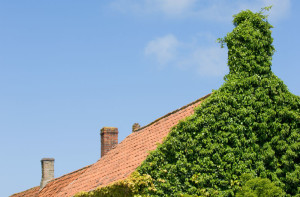Many people love the look of vines growing against a masonry chimney, but ivy and other attaching vines can cause extensive damage to the structure of a chimney, especially if the chimney was built before 1930. If you are looking to buy a historical home, you should be wary if a chimney is covered with climbing vines. The plants could be hiding damage to the bricks and mortar that could cause your chimney to be unsafe to use. If you try to investigate to see if there are cracked or missing bricks and mortar joints by pulling the vines away from the chimney, you could possibly end up pulling the chimney down as well. Our Chimney Safety Institute of America (CSIA)-certified chimney technicians at Blue Ridge Chimney Services have the experience and training in inspecting vine-covered chimneys, and we can safely determine if the plants are covering up damaged bricks and mortar joints. We would like to tell you why some vines are not good for masonry chimneys and to give you some tips if you do want to grow some type of greenery around your chimney.
Why are homes built before 1930 so much more vulnerable to masonry chimney damage from ivy and other climbing vines?

The answer to this question has to do with the kind of mortar that was used to build the chimney. Prior to 1930, mortar did not contain Portland cement, and this means the mortar is much more likely to suffer from erosion damage. Portland cement strengthens mortar, and without this cement in the mortar mix, the mortar is much weaker. Ivy and other climbing vines grow aggressively and will attach themselves into cracks and gaps in the chimney as they grow. The attachment of these plants into the masonry work further weakens the mortar, which is why you risk the danger of pulling the entire chimney down if you pull on the vines.
I really love the look of climbing vines against a chimney and would like to grow them. Is it possible to add vines without damaging my chimney?
Blue Ridge Chimney Services knows many people love the look of climbing vines up a masonry chimney, and we do have a few tips for you if you do want to add greenery to your chimney. Vines typically grow well without causing damage on well-built masonry chimneys, so we can inspect the condition of your older chimney to check the mortar for erosion damage. Our experienced chimney masons can restore any damage to give your chimney a solid base. We use tuckpointing techniques to remove old mortar and replace it with mortar that contains Portland cement. We would also like to strongly recommend that you install a support system such as trellis, lattice, or wire in front of your chimney to grow vines that will not attach directly to your chimney. This allows you to easily move the vines for maintenance purposes. Today’s Homeowner suggests planting flowering vines like wisteria, jasmine, clematis, and climbing roses on the support to add beautiful bits of color to the exterior of your home.
If your chimney is already covered with climbing vines, you need professional help to be sure the plants are not hiding any erosion damage. Contact us at Blue Ridge Chimney Services to schedule a chimney inspection today.
